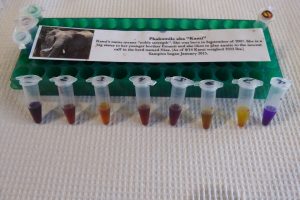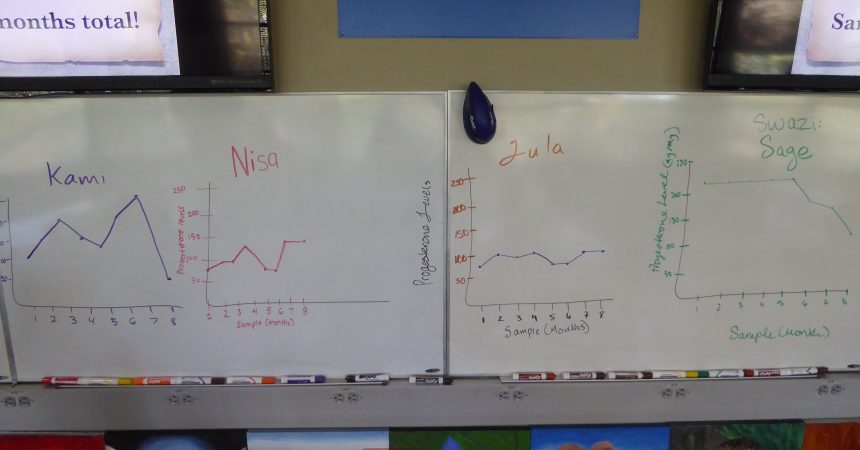Zoo InternQuest is a seven-week career exploration program for San Diego County high school juniors and seniors. Students have the unique opportunity to meet professionals working for the San Diego Zoo, Safari Park, and Institute for Conservation Research, learn about their jobs, and then blog about their experience online. Follow their adventure here on the Zoo’s website!

Just a stone’s throw away from the San Diego Zoo’s Safari Park is the Institute for Conservation Research, where important research in fields like Conservation Genetics and Reproductive Sciences is conducted. We visited the Institute for the first time this past Wednesday to meet with Ms. Victoria Dunch, a Research Associate who educates students on the many different conservation projects taking place at the Institute. That day, however, Ms. Dunch sought to inform us on a topic that I was particularly excited about: African elephant reproductive endocrinology!
First, Ms. Dunch gave us some history behind the Institute’s elephant endocrinology efforts. Back in 1975, the San Diego Zoo started to research animal reproduction at what was then called the Center for Reproduction of Endangered Species (CRES). When the Institute was built in 2004, the work that was being done at CRES was moved to the new location. Since then, the Institute has become one of the largest multi-disciplinary conservation research centers in the world.
Elephant reproduction has become a big concern for the Institute due to the numerous threats that are currently facing the wild African elephant population. Due to factors like poaching and habitat loss, the number of African elephants alive in the wild decreases by about 8% each year. As a result, San Diego Zoo Global has had an elephant breeding program in effect for over a decade, and one of the most important aspects of this program is reproductive endocrinology. Endocrinology is a field of reproductive medicine that specializes in the body’s hormonal functions.
The reproductive system of African elephants is actually strikingly similar to that of our species. During pregnancy, both humans and elephants develop placentas and produce high levels of progesterone, a hormone that represses the immune system so that the embryo does not get terminated. Progesterone levels correspond with the various stages of pregnancy in elephants, so researchers at the Institute regularly check the amount of progesterone produced by each female elephant at the Safari Park. Usually, the progesterone is extracted via urine or feces, but the Safari Park’s elephants have also been trained to provide saliva or blood samples should the situation arise.
In one of the Institute’s laboratories, Ms. Dunch introduced us to the tools that the researchers use to analyze elephant progesterone. In a test called the Competitive Enzyme-linked Immunosorbent Assay (ELISA), progesterone obtained from an animal is placed in a tube lined with receptors. Synthetic progesterone linked with an enzyme is also added. To put it in more simplified terms, imagine a round of musical chairs in which there are two types of contestants, Type A and Type B. If there are more players of Type A in the game, then statistically, more of the chairs will become occupied by Type A. In this analogy, the number of Type A players represents the amount of progesterone collected from an elephant at a certain point in time. If there is more elephant progesterone, then more of the receptors in the tube will bind with this type of progesterone. Then, a substrate that reacts with the enzyme in the synthetic progesterone by turning the color purple can be used to determine this amount – in a way, it’s like counting the number of Type A players by identifying how many people are not wearing a purple shirt.
Through this method, my fellow interns and I were able to successfully determine the progesterone levels of different female elephants over an eight-month period. Two of them turned out to be acyclic, meaning that their progesterone levels were not high enough to justify breeding them; one was found to be cycling but still fairly young; and one, we discovered, had just given birth!
At the end of her presentation, Ms. Dunch explained that breeding programs like the one at the Institute are just a minor solution for dealing with elephant population loss. In order to create a more profound impact, she recommended that we install the Cheyenne Mountain Zoo Palm Oil app to use when shopping. The app scans the bar codes of various products that use palm oil and identifies whether the oil was obtained through the deforestation of ecosystems occupied by elephants. As Ms. Dunch put it, “voting with your wallet” is really the most effective way to mitigate the dangers that we as a species impose upon the other inhabitants of this planet.
Sunwoo, Real World Team
Week Two, Fall Session 2017


